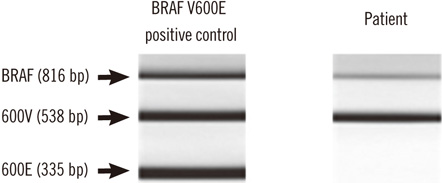Ann Lab Med.
2012 May;32(3):238-241. 10.3343/alm.2012.32.3.238.
Identification of a Rare 3 bp BRAF Gene Deletion in a Thyroid Nodule by Mutant Enrichment with 3'-Modified Oligonucleotides Polymerase Chain Reaction
- Affiliations
-
- 1Department of Laboratory Medicine & Genetics, Samsung Medical Center, Sungkyunkwan University School of Medicine, Seoul, Korea. changski@skku.edu, kimjw@skku.edu
- 2Department of Pathology, Samsung Medical Center, Sungkyunkwan University School of Medicine, Seoul, Korea.
- 3Department of Medicine, Samsung Medical Center, Sungkyunkwan University School of Medicine, Seoul, Korea.
- KMID: 1381693
- DOI: http://doi.org/10.3343/alm.2012.32.3.238
Abstract
- Papillary thyroid carcinoma (PTC) is the most common malignant thyroid tumor, and 36-69% of PTC cases are caused by mutations in the BRAF gene. The substitution of a valine for a glutamic acid (V600E) comprises up to 95-100% of BRAF mutations; therefore, most diagnostic methods, including allele-specific PCR and real-time PCR, are designed to detect this mutation. Nevertheless, other mutations can also comprise the genetic background of PTC. Recently, a novel and sensitive technique called mutant enrichment with 3'-modified oligonucleotides (MEMO) PCR has been introduced. When we applied allelespecific PCR and MEMO-PCR for the detection of the BRAF V600E mutation, we found an unusual 3' bp deletion mutation (c.1799_1801delTGA) only when using MEMO-PCR. This deletion results in the introduction of a glutamic acid into the B-Raf activation segment (p.V600_K601delinsE), leading to an elevated basal kinase activity of BRAF. This is the first report of a rare 3 bp BRAF deletion in a PTC patient that could not be detected by allele-specific PCR.
Keyword
MeSH Terms
Figure
Cited by 1 articles
-
Detection of MYD88 L265P in patients with lymphoplasmacytic lymphoma/Waldenstrom macroglobulinemia and other B-cell non-Hodgkin lymphomas
Sang-Yong Shin, Seung-Tae Lee, Hyun-Young Kim, Chang-Hun Park, Hee-Jin Kim, Jong-Won Kim, Seok Jin Kim, Won Seog Kim, Sun-Hee Kim
Blood Res. 2016;51(3):181-186. doi: 10.5045/br.2016.51.3.181.
Reference
-
1. Kimura ET, Nikiforova MN, Zhu Z, Knauf JA, Nikiforov YE, Fagin JA. High prevalence of BRAF mutations in thyroid cancer: genetic evidence for constitutive activation of the RET/PTC-RAS-BRAF signaling pathway in papillary thyroid carcinoma. Cancer Res. 2003. 63:1454–1457.2. Davies H, Bignell GR, Cox C, Stephens P, Edkins S, Clegg S, et al. Mutations of the BRAF gene in human cancer. Nature. 2002. 417:949–954.
Article3. Cohen Y, Xing M, Mambo E, Guo Z, Wu G, Trink B, et al. BRAF mutation in papillary thyroid carcinoma. J Natl Cancer Inst. 2003. 95:625–627.
Article4. Fukushima T, Suzuki S, Mashiko M, Ohtake T, Endo Y, Takebayashi Y, et al. BRAF mutations in papillary carcinomas of the thyroid. Oncogene. 2003. 22:6455–6457.
Article5. Trovisco V, Vieira de Castro I, Soares P, Maximo V, Silva P, Magalhaes J, et al. BRAF mutations are associated with some histological types of papillary thyroid carcinoma. J Pathol. 2004. 202:247–251.
Article6. Lee ST, Kim JY, Kown MJ, Kim SW, Chung JH, Ahn MJ, et al. Mutant enrichment with 3'-modified oligonucleotides a practical PCR method for detecting trace mutant DNAs. J Mol Diagn. 2011. 13:657–668.7. Lee EJ, Park CK, Kim JW, Chang DK, Kim KM. Deletion mutation of BRAF in a serrated adenoma from a patient with familial adenomatous polyposis. APMIS. 2007. 115:982–986.
Article8. Reifenberger J, Knobbe CB, Sterzinger AA, Blaschke B, Schulte KW, Ruzicka T, et al. Frequent alterations of Ras signaling pathway genes in sporadic malignant melanomas. Int J Cancer. 2004. 109:377–384.
Article9. Trovisco V, Soares P, Soares R, Magalhães J, Sá-Couto P, Sobrinho-Simões M. A new BRAF gene mutation detected in a case of a solid variant of papillary thyroid carcinoma. Hum Pathol. 2005. 36:694–697.
Article10. Milbury CA, Li J, Makrigiorgos GM. PCR-based methods for the enrichment of minority alleles and mutations. Clin Chem. 2009. 55:632–640.
Article
- Full Text Links
- Actions
-
Cited
- CITED
-
- Close
- Share
- Similar articles
-
- Evaluation of the Anyplex BRAF V600E Real-Time Detection Assay Using Dual-Priming Oligonucleotide Technology in Fine-Needle Aspirates of Thyroid Nodules
- Relation between RASSF1A Methylation and BRAF Mutation in Thyroid Tumor
- The Different Expression of BRAF(V600E) Mutation in Patients with Papillary Thyroid Carcinomas Coexisting with or without Benign Thyroid Nodules
- Diagnostic value of BRAF(V600E) mutation analysis in fine needle aspiration for evaluation of thyroid nodules
- Clinical Implication of BRAF Mutation in Thyroid Cancer




